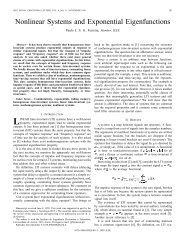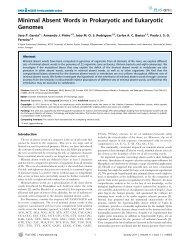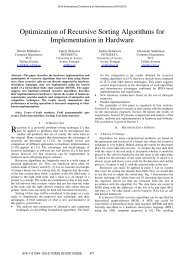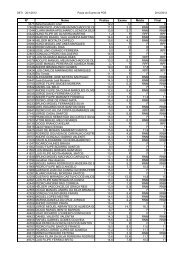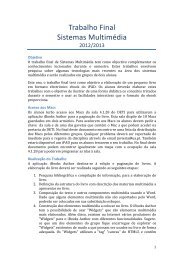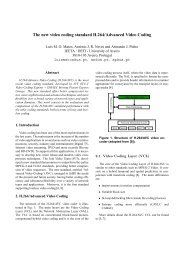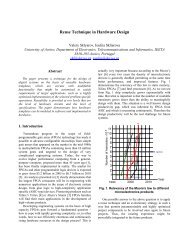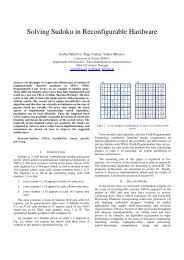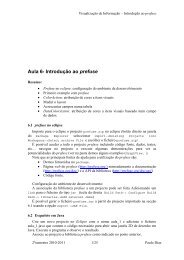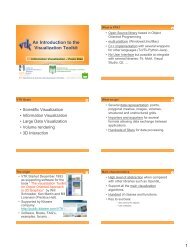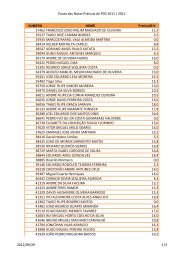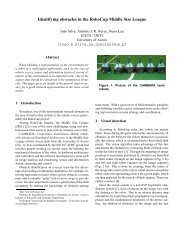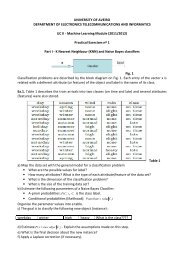DATA SHEET - IEETA
DATA SHEET - IEETA
DATA SHEET - IEETA
Create successful ePaper yourself
Turn your PDF publications into a flip-book with our unique Google optimized e-Paper software.
Philips Semiconductors Product specification<br />
8-bit microcontroller with on-chip CAN P8xC592<br />
12 SERIAL I/O PORT: SIO0 (UART)<br />
The Serial Port SIO0 is a full duplex (UART) serial I/O port<br />
i.e. it can transmit and receive simultaneously. This Serial<br />
Port is also receive-buffered. It can commence reception<br />
of a second byte before the previously received byte has<br />
been read from the receive register. However, if the first<br />
byte has still not been read by the time reception of the<br />
second byte is complete, one of these (first or second)<br />
bytes will be lost. The SIO0 receive and transmit registers<br />
are both accessed via the S0BUF SFR. Writing to S0BUF<br />
loads the transmit register, and reading S0BUF accesses<br />
to a physically separate receive register. SIO0 can operate<br />
in 4 modes:<br />
Mode 0 Serial data is transmitted and received through<br />
RXD. TXD outputs the shift clock. 8 data bits are<br />
transmitted/received (LSB first). The baud rate is<br />
fixed at 1 ⁄12 of the oscillator frequency.<br />
Mode 1 10 bits are transmitted via TXD or received<br />
through RXD: a start bit (0), 8 data bits (LSB first),<br />
and a stop bit (1). On receive, the stop bit is put<br />
into RB8 of the S0CON SFR. The baud rate is<br />
variable.<br />
Mode 2 11 bits are transmitted through TXD or received<br />
through RXD: a start bit (0), 8 data bits (LSB first),<br />
a programmable 9 th data bit, and a stop bit (1).<br />
On transmit, the 9 th data bit (TB8 in S0CON) can<br />
be assigned the value of 0 or 1. With nominal<br />
software, TB8 can be the parity bit (P in PSW).<br />
During a receive, the 9 th data bit is stored in RB8<br />
(S0CON), and the stop bit is ignored. The baud<br />
rate is programmable to either 1 ⁄32 or 1 ⁄64 of the<br />
oscillator frequency.<br />
Mode 3 11 bits are transmitted through TXD or received<br />
through RXD: a start bit (0), 8 data bits (LSB first),<br />
a programmable 9 th data bit, and a stop bit (1).<br />
Mode 3 is the same as Mode 2 except for the<br />
baud rate which is variable in Mode 3.<br />
In all four modes, transmission is initiated by any<br />
instruction that writes to the S0BUF SFR.<br />
Reception is initiated in Mode 0 when RI = 0 and REN = 1.<br />
In the other three modes, reception is initiated by the<br />
incoming start bit provided that REN = 1.<br />
Modes 2 and 3 are provided for multiprocessor<br />
communications. In these modes, 9 data bits are received<br />
with the 9 th bit written to RB8 (S0CON). The 9 th bit is<br />
followed by the stop bit. The port can be programmed so<br />
that with receiving the stop bit, the Serial Port interrupt will<br />
be activated if, and only if RB8 = 1.<br />
1996 Jun 27 27<br />
This feature is enabled by setting bit SM2 in S0CON. This<br />
feature may be used in multiprocessor systems.<br />
For more information about how to use the UART in<br />
combination with the registers S0CON, PCON, IE, SBUF<br />
and the Timer register, refer to the 8051-based<br />
“8-bit Microcontrollers Data Handbook IC20”.<br />
13 SERIAL I/O PORT: SIO1 (CAN)<br />
SIO1 (CAN) provides the CAN (Controller Area Network)<br />
serial-bus data communication interface. SIO1 (CAN)<br />
replaces the SIO1 (I 2 C) serial interface as provided in the<br />
microcontroller derivative P8xC552.<br />
13.1 On-chip CAN-controller<br />
CAN is the definition of a high performance<br />
communication protocol for serial data communication.<br />
The P8xC592 on-chip CAN-controller is a full<br />
implementation of the CAN 2.0A protocol. With the<br />
P8xC592 powerful local networks can be built, both for<br />
automotive and general industrial environments. This<br />
results in a much reduced wiring harness and enhanced<br />
diagnostic and supervisory capabilities.<br />
13.2 CAN Features<br />
• Multi-master architecture<br />
• Bus access priority determined by the message<br />
identifier<br />
• 2032 message identifier (211 standard frame CAN 2.0A)<br />
• Guaranteed latency time for high priority messages<br />
• Powerful error handling capability<br />
• Data length from 0 up to 8 bytes<br />
• Multicast and broadcast message facility<br />
• Non destructive bit-wise arbitration<br />
• Non-return-to-zero (NRZ) coding/decoding with<br />
bit-stuffing<br />
• Programmable transfer rate (up to 1 Mbit/s)<br />
• Programmable output driver configuration<br />
• Suitable for use in a wide range of networks including<br />
the SAE's network classes A, B and C<br />
• DMA providing high-speed on-chip data exchange<br />
• Bus failure management facility<br />
• 1 ⁄2AVDD reference voltage.



